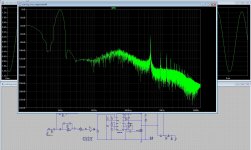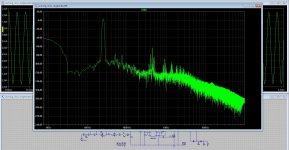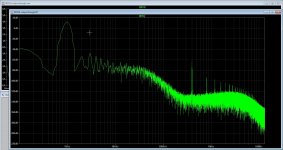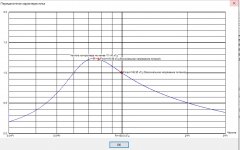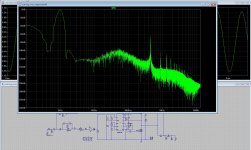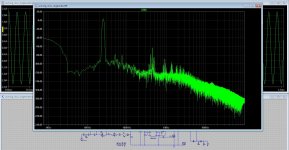The price of this board is nearly 500$... -> EPC9106, EPC EPC9106 в наличност. Купете EPC9106 с най-добра цена на Components-Store.com
500 USD crazy!
who want buy for development ?
500 USD crazy!
who want buy for development ?
I asked to get one these boards... Normally they are NOT FOR SALE, see on their site and I also got an answer from EPC, they told me that they are not available anymore.
You can make it yourself with this Shematic :
https://epc-co.com/epc/Portals/0/epc/documents/schematics/EPC9106_Schematic.pdf
EPC9106


I'm not sure if bg.components-store.com are really in compliance ..
Last edited:
I am not sure what's up in this field of GaN classD, I am super interested in listening to these amps but the sector appears to be chock full of snake oil and vaporware salesmen. A quick google will bring up all sorta outfits apparently 'shipping now'. I sent a couple of emails inquires and dealt with some real flakes. That includes the outfit in Austin TX that apparently commissioned the EPC eval board.
The closest thing to a buyable product is here (it ain't cheap!):
GS-EVB-AUD-BUNDLE1-GS GaN Systems | Mouser
The closest thing to a buyable product is here (it ain't cheap!):
GS-EVB-AUD-BUNDLE1-GS GaN Systems | Mouser
I'm not sure if bg.components-store.com are really in compliance ..
Whatever you do, don't buy from them. It's a scam site.
For GaN amps, look here:BOSC - HiFi Monoblock Class-D GaN Amp
Excellent performance, and finished boards or even PCB's available.
You can make it yourself with this Shematic :
https://epc-co.com/epc/Portals/0/epc/documents/schematics/EPC9106_Schematic.pdf
Interesting to do it
drMordor,
this is an interesting schematic, particularly the full bridge design which IMO is the only way to realize the full potential of these class D devices. However, the gan fet and controller may already be outdated and better stuff maybe available.
You should look into it and keep us posted. I have downloaded the gerbers files for the board. They are out there.
this is an interesting schematic, particularly the full bridge design which IMO is the only way to realize the full potential of these class D devices. However, the gan fet and controller may already be outdated and better stuff maybe available.
You should look into it and keep us posted. I have downloaded the gerbers files for the board. They are out there.
Right now the audio performance of the GaN amps is stratospheric, much better than you can hear. There’s room to compromise between audio performance and expense. I think that as the market matures you will see great performance for a better price than is currently available with Si class d amps.
In a traditional design they aren’t, but they’re a big advantage in class D designs because of their much faster switching time.
Depends on correct implementation. Shematic, PCB, etc...Right now the audio performance of the GaN amps is stratospheric
I guess that's a matter of perspective. GaNFETs are only a few dollars each; often about the same price as MOSFETs.GaNFETs are expensive, and not really that big of an advantage in audio.
It seems that the speed isn't an advantage anymore, simply because of how much MOSFETs have improved in the last few years. But the body diode issue is a definite advantage.
The chip I did use is lowest 15nS.
I have downloaded a .lib for ltspice but have no part .cpy I need to now how to make, I think just a square with the pin names from the .lib will do.
Then I can spice more precisely.
I did see the Gan mosfets are also in to220? but the induction of pins and pcb traces does get nasty very quick.
What Gan did you use>? the abcense of the body diode is a really gainer, these is even more important then the speed.
I did look ad your projects, I have a question about the LLC smps you use, I have been seen that a unregulated LLC is the best for audio, this because of the fast transients
what never can be properly regulated, the feedback is way to slow for that.
I did search for calculations for the transformer, and special for the hybrid amp who use multiply voltages, like 300 volts, 2 x 150 volts for the tubes, and filament voltages, maybe it is better to make a smps for the amp itself as a separayed supply with 2 x 65 volts 15 amps, or 10 amps.
Maybe there is software for calculation for transformer or a measurement bridge, I think resonance will change when using more voltages, and then there is a need of
calculation or experimenting. Where you put the resonance point for full zero switching? It is above resonance but for open loop smps it needs to be right for minimum fluctuations
of voltage onder load.
regards
I have downloaded a .lib for ltspice but have no part .cpy I need to now how to make, I think just a square with the pin names from the .lib will do.
Then I can spice more precisely.
I did see the Gan mosfets are also in to220? but the induction of pins and pcb traces does get nasty very quick.
What Gan did you use>? the abcense of the body diode is a really gainer, these is even more important then the speed.
I did look ad your projects, I have a question about the LLC smps you use, I have been seen that a unregulated LLC is the best for audio, this because of the fast transients
what never can be properly regulated, the feedback is way to slow for that.
I did search for calculations for the transformer, and special for the hybrid amp who use multiply voltages, like 300 volts, 2 x 150 volts for the tubes, and filament voltages, maybe it is better to make a smps for the amp itself as a separayed supply with 2 x 65 volts 15 amps, or 10 amps.
Maybe there is software for calculation for transformer or a measurement bridge, I think resonance will change when using more voltages, and then there is a need of
calculation or experimenting. Where you put the resonance point for full zero switching? It is above resonance but for open loop smps it needs to be right for minimum fluctuations
of voltage onder load.
regards
Last edited:
I have start this Thread and stop longtime Class D with ICs.
Its not worth spend time except IR2110 based circuits with double feedback
and without good PCB design no way, Class D have to big holes to fall in
Its not worth spend time except IR2110 based circuits with double feedback
and without good PCB design no way, Class D have to big holes to fall in
Last edited:
I have experience with pcb who needs very short traces, like I did with RF transmitters (60 to 900 Mhz).
But I need a hot air station, so if you can advise one who is not expensive (I do just hobby).
I have now work on a circlotron autobias system and a hybrid, for that hybrid I have need that LLC smps, butbecause I need multiply voltages calculation of transformer is difficult without a program.
An russian guy did excellentIT 7300 but have also from him a version for resonant who is not whole english.
But I need a hot air station, so if you can advise one who is not expensive (I do just hobby).
I have now work on a circlotron autobias system and a hybrid, for that hybrid I have need that LLC smps, butbecause I need multiply voltages calculation of transformer is difficult without a program.
An russian guy did excellentIT 7300 but have also from him a version for resonant who is not whole english.
Last edited:
For the comparator I do use a version who has 3 nS speed.
open loop with Gan did on sim twice as good distortions in compare with normal mosfets.
With a three level 1Mhz (mosfets do 500 Khz three level does double that) switching amp I get -120dB on 1 khz anbd -80dB on 25 Khz.
in real live ? I do not now but will set inductions in series with mosfet pins to simulate pcb traces and watch them.
open loop with Gan did on sim twice as good distortions in compare with normal mosfets.
With a three level 1Mhz (mosfets do 500 Khz three level does double that) switching amp I get -120dB on 1 khz anbd -80dB on 25 Khz.
in real live ? I do not now but will set inductions in series with mosfet pins to simulate pcb traces and watch them.
Attachments
Last edited:
- Home
- Amplifiers
- Class D
- Class D with GaN FETs & IC PE29102 (GaN FET) driver
